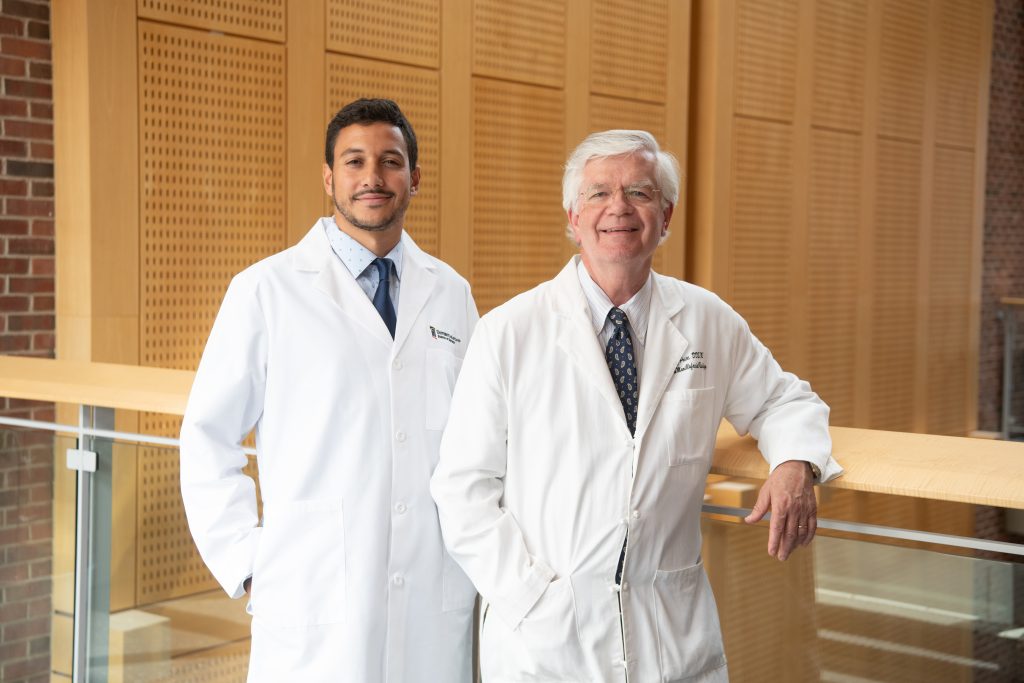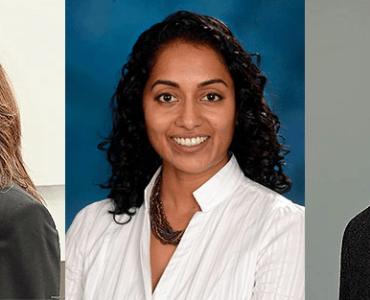
On the seventh floor of the University of Maryland School of Dentistry (UMSOD), Ahmed Sultan, BDS, PhD, and Jeffery B. Price, DDS, MS, are working to expand the boundaries of artificial intelligence-assisted diagnostics to develop new ways of diagnosing diseases and creating dental and dental predictive models with greater transparency, precision, and, ultimately, better patient outcomes.
It is an ambitious and potentially transformative project — part of UMSOD’s new Division of Artificial Intelligence (AI) Research. Housed in the Department of Oncology and Diagnostic Sciences (ODS), it is directed by Sultan, assistant professor, program director of Oral and Maxillofacial Pathology Residency, and co-director of Oral Medicine Programs at the University of Maryland Marlene and Stewart Greenebaum Comprehensive Cancer Center and UMSOD.
The division will include a multidisciplinary team of faculty, postdoctoral researchers, and doctoral and dental students, co-directed by Price, clinical professor and director of the Division of Oral Radiology, ODS.
“At the School of Dentistry, we have access to enormous data sets of invaluable information, including that of rare oral diseases and cancers,” Sultan said. “By mining that data and collaborating with the multidisciplinary teams of experts at UMSOD, the University of Maryland School of Medicine, and our external computer vision AI experts, we can explore and expand the potential of AI in oral and maxillofacial medicine, pathology, and radiology.”
Developing AI models that can explain how they reach their decisions is another priority for the division, Price said. Only then can practitioners confidently apply AI findings and improve their own diagnoses and treatment plans. He noted that while AI is used increasingly in the medical fields, a 2022 survey conducted by the Pew Research Center found that 60 percent of the 11,000 respondents would not feel comfortable if their health care providers relied on artificial intelligence to diagnose and propose treatments.
“Our mission statement includes the phrase ‘explainable, interpretable, and transparent AI,’ ” Price said. “AI algorithms can be developed so that the program will explain how it makes its decisions. And by creating interpretable or explainable AI models, we will be able to allow clinicians to see what and how predictions are made by AI, and this will build trust.”
Through the use of Institutional Review Board-approved research projects, the new division has access to UMSOD’s imaging and patient record databases. Over the course of several years, for example, Sultan used a virtual slide microscope scanner, which is able to scan 100 slides at extremely high resolution at once, to transform more than 27,000 oral pathology glass slides from tissue samples to digital whole slide images (WSI).
In addition, the oral radiology data set includes about 500,000 digital radiographic images drawn from the school’s archives.
“It is safe to say that UMSOD is one of the only dental schools in the U.S. to have such an extensive, high-resolution, oral radiology cone beam computed topography [CBCT] images and oral pathology WSI database,” Sultan said.
Ultimately, the plan is to merge and continue building upon the imaging information, as well as to incorporate UMSOD’s approximately 100,000 active dental axiUm records that include structured (non-free text data such as e-prescriptions, periodontal charting, hard tissue dental charting, etc.) and unstructured data (i.e., free-text notes written by clinicians).
“The idea is to use our data from UMSOD — not ‘general’ data from the internet, but our data — and train our AI algorithms so they are accurate and reliable,” Price said.
Published Research Findings
The division already has produced interesting research findings. One article about AI-assisted detection of calcifications within the carotid arteries on dental CBCT was published in Oral Surgery, Oral Medicine, Oral Pathology, and Oral Radiology in August.
Price and Sultan were among the co-authors from UMSOD, along with Shahd A. Alajaji, BDS, doctoral student, Division of AI Research; Radi Masri, DDS, MS, PhD, professor and chief, Division of Prosthodontics, and director, Postgraduate Prosthodontics in the Department of Advanced Oral Sciences and Therapeutics; and Vandana Kumar, DDS, MS, part-time faculty, ODS.
The article described the potential for using AI methods in medical image analysis to alert clinicians to the presence of significant incidental pathology. It also highlighted the potential of how AI models, by using already available standard-of-care images, can contribute to more timely referrals of cardiovascular disease — and lead to improved patient outcomes.
AI can segment different anatomical features in the head and neck such as the mandible and the spine, Sultan said. But it also can depict more subtle features such as carotid calcifications that, if detected early, could lead to the prevention of strokes and myocardial infarction.
“We know dental practices are very busy, and not all dentists have the additional training to review anatomic findings and abnormalities in the skull base or in the neck,” Sultan said. “And what AI models can do is highlight exceedingly small subtleties, very minute calcifications that could indicate a need for an early referral to a cardiovascular specialist.”
Sultan and Price serve on working groups formed by the American Dental Association (ADA) that are charged with developing the U.S. position on AI and dental informatics. ADA is accredited by the American National Standards Institute to develop the U.S. position on all international dental standards.
‘Holy Grail of AI’
Looking ahead, the division has several other exciting projects in the works including assessing six medical AI chatbots in terms of quality and safety of patient-level dental and medical information for important oral mucosal conditions and investigating the ethical implications of generative adversarial networks, a new form of AI that generates synthetic image data to supplement rare data sets.
There also are ambitious plans to expand the division’s research capabilities. Most AI results today are accurate about 90 percent of the time — about the same level of accuracy as medical and oral radiologists and clinicians, Price said.
“Of course, AI is a lot faster. But how do you reach that final holy grail of AI being accurate at detecting abnormalities more than 90 percent of the time so that you can rely on it all the time?” he said. “The goal is for greater accuracy so it is even more accurate and faster than humans, and that it is trusted by clinicians and researchers — and patients. And that’s who we’re ultimately serving.”



